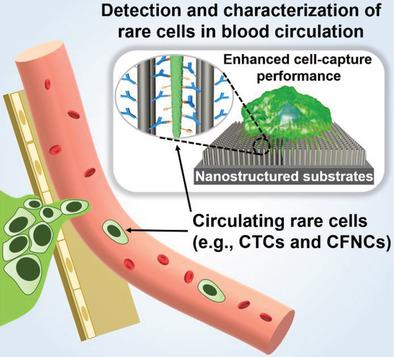当前位置:
X-MOL 学术
›
Adv. Mater.
›
论文详情
Our official English website, www.x-mol.net, welcomes your
feedback! (Note: you will need to create a separate account there.)
Nanostructured Substrates for Detection and Characterization of Circulating Rare Cells: From Materials Research to Clinical Applications.
Advanced Materials ( IF 27.4 ) Pub Date : 2019-09-30 , DOI: 10.1002/adma.201903663 Jiantong Dong 1, 2 , Jie-Fu Chen 3 , Matthew Smalley 1 , Meiping Zhao 2 , Zunfu Ke 4 , Yazhen Zhu 1 , Hsian-Rong Tseng 1
Advanced Materials ( IF 27.4 ) Pub Date : 2019-09-30 , DOI: 10.1002/adma.201903663 Jiantong Dong 1, 2 , Jie-Fu Chen 3 , Matthew Smalley 1 , Meiping Zhao 2 , Zunfu Ke 4 , Yazhen Zhu 1 , Hsian-Rong Tseng 1
Affiliation

|
Circulating rare cells in the blood are of great significance for both materials research and clinical applications. For example, circulating tumor cells (CTCs) have been demonstrated as useful biomarkers for "liquid biopsy" of the tumor. Circulating fetal nucleated cells (CFNCs) have shown potential in noninvasive prenatal diagnostics. However, it is technically challenging to detect and isolate circulating rare cells due to their extremely low abundance compared to hematologic cells. Nanostructured substrates offer a unique solution to address these challenges by providing local topographic interactions to strengthen cell adhesion and large surface areas for grafting capture agents, resulting in improved cell capture efficiency, purity, sensitivity, and reproducibility. In addition, rare-cell retrieval strategies, including stimulus-responsiveness and additive reagent-triggered release on different nanostructured substrates, allow for on-demand retrieval of the captured CTCs/CFNCs with high cell viability and molecular integrity. Several nanostructured substrate-enabled CTC/CFNC assays are observed maturing from enumeration and subclassification to molecular analyses. These can one day become powerful tools in disease diagnosis, prognostic prediction, and dynamic monitoring of therapeutic response-paving the way for personalized medical care.
中文翻译:

用于检测和表征循环稀有细胞的纳米结构底物:从材料研究到临床应用。
血液中循环的稀有细胞对于材料研究和临床应用都具有重要意义。例如,循环肿瘤细胞 (CTC) 已被证明是肿瘤“液体活检”的有用生物标志物。循环胎儿有核细胞 (CFNC) 在无创产前诊断中显示出潜力。然而,检测和分离循环稀有细胞在技术上具有挑战性,因为与血液细胞相比,它们的丰度极低。纳米结构底物通过提供局部地形相互作用来增强细胞粘附和大表面积接枝捕获剂,从而提高细胞捕获效率、纯度、灵敏度和可重复性,从而为应对这些挑战提供独特的解决方案。此外,稀有细胞修复策略,包括刺激响应性和不同纳米结构基材上的加性试剂触发释放,允许按需修复捕获的具有高细胞活力和分子完整性的 CTC/CFNC。观察到几种纳米结构底物支持的 CTC/CFNC 测定从计数和亚分类到分子分析的成熟。这些有朝一日可以成为疾病诊断、预后预测和治疗反应动态监测的有力工具,为个性化医疗护理铺平道路。
更新日期:2020-01-07
中文翻译:

用于检测和表征循环稀有细胞的纳米结构底物:从材料研究到临床应用。
血液中循环的稀有细胞对于材料研究和临床应用都具有重要意义。例如,循环肿瘤细胞 (CTC) 已被证明是肿瘤“液体活检”的有用生物标志物。循环胎儿有核细胞 (CFNC) 在无创产前诊断中显示出潜力。然而,检测和分离循环稀有细胞在技术上具有挑战性,因为与血液细胞相比,它们的丰度极低。纳米结构底物通过提供局部地形相互作用来增强细胞粘附和大表面积接枝捕获剂,从而提高细胞捕获效率、纯度、灵敏度和可重复性,从而为应对这些挑战提供独特的解决方案。此外,稀有细胞修复策略,包括刺激响应性和不同纳米结构基材上的加性试剂触发释放,允许按需修复捕获的具有高细胞活力和分子完整性的 CTC/CFNC。观察到几种纳米结构底物支持的 CTC/CFNC 测定从计数和亚分类到分子分析的成熟。这些有朝一日可以成为疾病诊断、预后预测和治疗反应动态监测的有力工具,为个性化医疗护理铺平道路。































 京公网安备 11010802027423号
京公网安备 11010802027423号